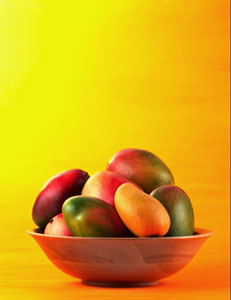Maximum Mango in the Commercial Kitchen
Super UserCourtesy of the National Mango Board
 Contrary to popular belief, the mango is available any time of year, and the Orlando, Fla.-based National Mango Board (NMB) has made it its mission to educate U.S. consumers on selection and preparation of the world’s most consumed fruit. Since 1995, mango consumption has increased by 100% in the United States (U.S. Outlook Report 2004). Approximately only 30% of U.S. households consume mangos today, however.
Contrary to popular belief, the mango is available any time of year, and the Orlando, Fla.-based National Mango Board (NMB) has made it its mission to educate U.S. consumers on selection and preparation of the world’s most consumed fruit. Since 1995, mango consumption has increased by 100% in the United States (U.S. Outlook Report 2004). Approximately only 30% of U.S. households consume mangos today, however.
This Lesson Plan instructs on a basic technique for slicing a mango in a decorative pattern, delivered by Allen Susser, chef/owner of famed Chef Allen’s in Aventura, Fla., and author of such books as The Great Mango Book (Ten Speed Press, 2001) and Allen Susser’s New World Cuisine (Broadway, 1995). Included are two differently formatted charts highlighting mango varieties and their seasonalities.
For instructors, the following information may prove useful in discussing availability, proper selection, storage, prepping and nutritional value of mangos with students:
There are six major varieties of mangos available in the United States at overlapping seasons throughout the year. They vary in size, shape and color, but the flavors are fairly consistent.
Don’t be fooled by the fruit’s skin color, as it has little to do with its ripeness. Regardless of external color, the flesh of any mango variety promises to be juicy and flavorful at the point of sale.
Not surprisingly, mangos are also naturally good for you. The mango is an excellent source of vitamins A and C, and a good source of fiber. It has a variety of antioxidants, including beta carotene, which is responsible for the mango’s brightly colored flesh.
Selecting Mangos
Color is not a determining factor of a mango’s ripeness. The best way to determine if the fruit is ripe is to squeeze it gently. The mango should give slightly, but not be too soft. It should have a sweet, fruity scent. If there is no scent, there will probably be less flavor.
Ripening and Storing Mangos
When ripening, mangos should be stored on the counter at room temperature. They will continue to ripen, becoming sweeter and softer.
To ripen faster, place mangos in a paper bag with bananas or apples.
Ripe mangos should be stored in the refrigerator, as cold storage slows down the ripening. Store ripe mangos for up to five days in the refrigerator wrapped in a plastic bag.
Frozen mango may be peeled, cubed and stored in an airtight container for up to six months.
Cutting Mangos
A mango has one seed in the center of the fruit.
Cutting off the sides: Place the mango with one of its narrower sides facing up.
Starting ¼ inch from the stem, slide along each side of the pit to cut off the “cheeks.”
Peel skin from cheeks and slice or dice as needed.
For a decorative cut, cut the cheeks as noted above. With the skin side of the cheeks on a cutting board, cut the flesh crisscross, being careful not to cut through the skin. Press the skin so the fruit cubes pop outward. With a spoon or knife, scrape off the mango cubes. Several mango splitters are now available at specialty stores.
Usage Ideas for Mangos
Fresh mangos are most frequently eaten plain, either whole or sliced. Some enhance the flavor of the mango with salt or lime juice and chile pepper.
Mangos have tenderizing properties, making them a perfect ingredient for marinades.
Mangos complement coconut, pineapple, raspberries, chicken and pork.
Visit the NMB’s Web site at www.mangoinfo.org for additional facts and recipes.
Download attachments:
- Download the Lesson Plan (1132 Downloads)
Leave a comment
Make sure you enter all the required information, indicated by an asterisk (*). HTML code is not allowed.

